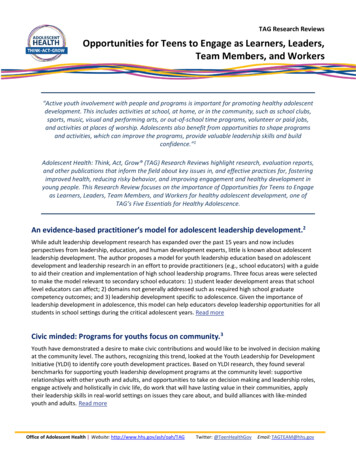
Transcription
TAG Research ReviewsOpportunities for Teens to Engage as Learners, Leaders,Team Members, and Workers“Active youth involvement with people and programs is important for promoting healthy adolescentdevelopment. This includes activities at school, at home, or in the community, such as school clubs,sports, music, visual and performing arts, or out-of-school time programs, volunteer or paid jobs,and activities at places of worship. Adolescents also benefit from opportunities to shape programsand activities, which can improve the programs, provide valuable leadership skills and buildconfidence.”1Adolescent Health: Think, Act, Grow (TAG) Research Reviews highlight research, evaluation reports,and other publications that inform the field about key issues in, and effective practices for, fosteringimproved health, reducing risky behavior, and improving engagement and healthy development inyoung people. This Research Review focuses on the importance of Opportunities for Teens to Engageas Learners, Leaders, Team Members, and Workers for healthy adolescent development, one ofTAG’s Five Essentials for Healthy Adolescence.An evidence-based practitioner’s model for adolescent leadership development.2While adult leadership development research has expanded over the past 15 years and now includesperspectives from leadership, education, and human development experts, little is known about adolescentleadership development. The author proposes a model for youth leadership education based on adolescentdevelopment and leadership research in an effort to provide practitioners (e.g., school educators) with a guideto aid their creation and implementation of high school leadership programs. Three focus areas were selectedto make the model relevant to secondary school educators: 1) student leader development areas that schoollevel educators can affect; 2) domains not generally addressed such as required high school graduatecompetency outcomes; and 3) leadership development specific to adolescence. Given the importance ofleadership development in adolescence, this model can help educators develop leadership opportunities for allstudents in school settings during the critical adolescent years. Read moreCivic minded: Programs for youths focus on community.3Youth have demonstrated a desire to make civic contributions and would like to be involved in decision makingat the community level. The authors, recognizing this trend, looked at the Youth Leadership for DevelopmentInitiative (YLDI) to identify core youth development practices. Based on YLDI research, they found severalbenchmarks for supporting youth leadership development programs at the community level: supportiverelationships with other youth and adults, and opportunities to take on decision making and leadership roles,engage actively and holistically in civic life, do work that will have lasting value in their communities, applytheir leadership skills in real-world settings on issues they care about, and build alliances with like-mindedyouth and adults. Read moreOffice of Adolescent Health Website: http://www.hhs.gov/ash/oah/TAGTwitter: @TeenHealthGovEmail: TAGTEAM@hhs.gov
Connection between adolescent's exposure to community violence and future civicengagement behaviors during their young adulthood.4Exposure to violence during adolescence may decrease an individual’s subsequent civic engagement inadulthood. The study included a sample of 10,298 individuals who were exposed to violence in the communityduring adolescence but were not exposed to violence in young adulthood. The authors found that that longterm effect of exposure to violence in the community decreased the likelihood of adolescents’ involvementwith community services when they become young adults. The results persisted after controlling for theinfluence of individual demographic characteristics, family socioeconomic background, and the protectiveeffects associated with having a good relationship with the primary caregiver. Read moreDeveloping a paradigm model of youth leadership development and communityengagement: A grounded theory.5Previous youth leadership development studies have used a variety of theoretical frameworks to examineyouth leadership development. The study sought to construct a grounded theory to describe the process ofhow youth leaders develop through community engagement. The authors specifically wanted to understand:1) what conditions caused the youth to engage in their community, 2) the strategies used by the youth and theadults when working together, 3) the conditions that helped or hindered those strategies, and 4) the resultingoutcomes. A paradigm model was developed to describe how community engagement influences thedevelopment of youth leaders. The authors found that individual connections (between youth adults),common sentiments, and being asked to engage were identified as the most salient causal conditions for youthto engage in their community. Read moreDoes it matter if students experience school as a place of community?6In the United States, school-aged children spend more time at school than anywhere else outside the home.This brief looked at whether or not schools served as a place of community and student engagement and therelationship between school connectedness and engagement to a sense of community and belonging.While the authors note that they believe that school community captures the essence of these relationshipsbecause members of a community feel that they belong, that they matter to each other, and that their needswill be met through their interactions, they also found that a significant portion of school-aged students do notfeel that they belong, are safe, matter to others, and their needs will be met at school. The authorsrecommend that as schools evaluate current practices, they can improve school-wide and classroom practicesto help every child experience a true sense of community that enhances their academic, behavioral, social, andemotional well-being. Read moreEngagement in school and community civic activities among rural adolescents.7Involvement in civic and community activities has been shown to be a core part of positive youth development.The study examined the civic activities of rural adolescents from small schools (school, community, andreligious activity involvement) and compared youth involved in civic activities with those who are not in termsof psychological well-being, problem behavior, academic engagement, and perceptions of parents. The currentstudy included 679 eighth and ninth graders from 13 small schools in rural areas of the Midwestern UnitedStates. Adolescents who participated in religious youth groups reported more extracurricular activities, lessOffice of Adolescent Health Website: http://www.hhs.gov/ash/oah/TAGTwitter: @TeenHealthGovEmail: TAGTEAM@hhs.gov
problem behavior, higher grades and motivation, and more support from parents and friends than adolescentswho did not participate in such groups. Similarly, adolescents who were involved in school- and communitybased civic activities reported more religiosity, academic engagement, and positive perceptions of parents andpeers than uninvolved youth. The results highlight the importance of civic activity engagement and itsassociation with positive youth development. Read moreHarnessing health information to foster disadvantaged teens' communityengagement, leadership skills, and career plans: A qualitative evaluation of theTeen Health Leadership Program.8The Teen Health Leadership Program (THLP) is a pilot program that engages at-risk high school students inhealth information advocacy and outreach, and focuses specifically on increasing teens’ 1) health informationliteracy, 2) leadership skills and community engagement, and 3) interest in careers in health care andbiomedicine. The target population included high school students in a low-income, primarily minoritycommunity near Charleston, South Carolina. Using semi-structured interviews, the authors found that theprogram had a positive impact on the participants' health information competency, leadership skills, academicorientation, and interest in health careers. The study suggests that health information can provide a powerfulcontext for increasing disadvantaged students' community engagement, leadership skills, and academicsuccess. Read moreThirty-year trends in U.S. adolescents' civic engagement: A story of changingparticipation and educational differences.9Using data from Monitoring the Future, a study that has surveyed a nationally representative sample of highschool seniors each year since 1976, the authors examined trends in high school seniors' current andanticipated civic participation and beliefs over a 30-year period. The study looked at trends in conventional,alternative, and community service participation and found that in the last 15 years high school seniors, onaverage, have been less likely to endorse alternative political engagement activities, their support forconventional political engagement remained considerably lower than in the previous 15 years, and yet theywere increasingly likely to volunteer in their communities. In addition, youth who planned to graduate from afour-year college were more civically inclined than their peers with a two-year college degree or no collegeplans. Read moreYouth as engaged citizens and community change advocates through the LexingtonYouth Leadership Academy.10The Lexington Youth Leadership Academy (LYLA) is a leadership development and community change programfor high school-aged youth. The goal of the program is to develop teens into effective leaders throughparticipation in community change and instilling the importance of communal decision making amongparticipants. LYLA is a community-based program and activities take place after school, on weekends, andduring summer months. Youth in this program are called Ambassadors and are required to complete aminimum of six trainings per year that focus on development of leadership skills, reduction of prejudice,improved self-concept, and civic responsibility. Preliminary findings of the LYLA suggest that the program had apositive impact on the youth who participated, and was welcomed by adults in the community, schools, andlocal organizations, but little is known about the long-term impact and whether it is more effective than otheryouth leadership programs such as peer mentoring within schools. Read moreOffice of Adolescent Health Website: http://www.hhs.gov/ash/oah/TAGTwitter: @TeenHealthGovEmail: TAGTEAM@hhs.gov
Youth development and leadership in programs.11The authors of this article state that administrators and policymakers should use the concepts of youthdevelopment and youth leadership in developing and administering programs that serve all youth andactivities and in programs specifically geared toward youth with disabilities. They recommend that youthdevelopment programs strive to provide supports, services, and opportunities that help youth, includingyouth with disabilities, achieve positive outcomes in five specific areas: working, learning, thriving,connecting, and leading. The authors suggest that all youth have multiple opportunities to observe, practice,and develop leadership skills; experience progressive roles of leadership ranging from leading a small groupto planning an event; receive education on the values and history of the organization; and learn to assesstheir own strengths and set goals for personal development. Read moreOffice of Adolescent Health Website: http://www.hhs.gov/ash/oah/TAGTwitter: @TeenHealthGovEmail: TAGTEAM@hhs.gov
1U.S. Department of Health and Human Services, Office of Adolescent Health. (April, 2016). Adolescent Health:Think, Act, Grow 2016 playbook. Washington, D.C.: U.S. Government Printing Office.2Rehm, C.J. (2014). An evidence-based practitioner’s model for adolescent leadership development. Journal ofLeadership Education, 83-97. doi:1012806/V13/I3/T1.3Yu, H.C., & Lewis-Charp, H. (2006). Civic minded: Programs for youths focus on community. Leadership inAction, 26(3), 7-10.4Chen, W.Y., Propp, J., & Lee, Y. (2015). Connection between adolescent's exposure to community violence andfuture civic engagement behaviors during their young adulthood. Child & Adolescent Social Work Journal, 32(1),45-55. doi:10.1007/s10560-014-0361-5.5Hastings, L., Barrett, L.A., Barbuto, J.E., & Bell, L.C. (2011). Developing a paradigm model of youth leadershipdevelopment and community engagement: A grounded theory. Journal of Agricultural Education, 52(1), 19-29.doi: 10.5032/jae.2011.01019.6Grover, H.M., Limber, S.P., & Boberiene, L.V. (2015). Does it matter if students experience school as a place ofcommunity? American Journal of Orthopsychiatry, 85(6), 79-85. doi: http://dx.doi.org/10.1037/ort0000131.7Ludden, A. (2011). Engagement in school and community civic activities among rural adolescents. Journal ofYouth & Adolescence, 40(9), 1254-1270. doi:10.3163/1536-5050.103.2.005.8Keselman, A., Ahmed, E.A., Williamson, D.C., Kelly, J.E., & Dutcher, G.A. (2015). Harnessing health informationto foster disadvantaged teens' community engagement, leadership skills, and career plans: A qualitativeevaluation of the Teen Health Leadership Program. Journal of the Medical Library Association, 103(2), 82-86.doI:10.3163/1536-5050.103.2.005.9Syvertsen, A., Wray-Lake, L., Flanagan, C., Osgood, W., & Briddell, L. (2011). Thirty-year trends in U.S.adolescents' civic engagement: A story of changing participation and educational differences. Journal ofResearch on Adolescence, 21(3), 586-594. doi:10.1111/j.1532-7795.2010.00706.x.10Otis, M.D. (2006). Youth as engaged citizens and community change advocates through the Lexington YouthLeadership Academy. Journal of Community Practice, 14(1/2), 71-88. doi:10.1300/J125v14n01-05.11National Collaborative on Workforce and Disability. (2005). Youth development and leadership in programs.Info Brief, 11, 1-8.Office of Adolescent Health Website: http://www.hhs.gov/ash/oah/TAGTwitter: @TeenHealthGovEmail: TAGTEAM@hhs.gov
Youth as engaged citizens and community change advocates through the Lexington Youth Leadership Academy. 10 The Lexington Youth Leadership Academy (LYLA) is a leadership development and community change program for high school-aged youth. The goal of the program is to develop teens into effective leaders through










